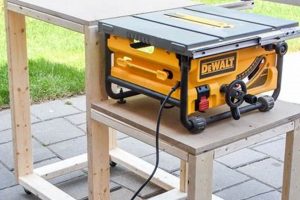A structure created at home, typically from readily available materials, to elevate a portable computer is the subject of this discussion. The purpose of such a construction is to improve ergonomics, promote better cooling, or create a more comfortable and efficient workspace. Examples include using stacked books, repurposed boxes, or crafted assemblies of wood or metal to raise the laptop screen to a more eye-level position.
Such solutions offer several advantages. These include improved posture, potentially reducing neck and back strain associated with prolonged laptop use. They can also facilitate better airflow around the device, mitigating overheating issues. Historically, users have sought customized solutions to computer ergonomics since the advent of portable computing, leading to a surge in self-made accessories as a cost-effective and personalized alternative to commercially available products.
The following sections will delve into various design considerations, material options, and construction techniques relevant to building such a device, as well as explore the ergonomic and functional benefits that can be realized.
Construction Considerations for a Laptop DIY Stand
The following provides guidance on factors to consider during the design and construction of a homemade laptop elevation device. Prior planning and attention to detail can result in a functional and aesthetically pleasing outcome.
Tip 1: Stability is Paramount: The structural integrity of the support must be ensured. A wobbly or unstable construction poses a risk of the laptop falling, potentially causing damage. Implement wide bases, secure joints, and test load-bearing capacity before extended use.
Tip 2: Ergonomic Height Assessment: Determine the optimal height for the laptop screen to align with the user’s eye level. Measure the distance from the desk surface to the user’s eyes while seated in a comfortable posture. This measurement will inform the required height of the stand.
Tip 3: Material Selection Based on Function: Consider the weight and heat dissipation properties of the chosen material. Wood, metal, and durable plastics are viable options. Wood provides a natural aesthetic, metal offers robustness, and plastic can be lightweight and easily molded. Ensure the material can support the laptop’s weight without deformation.
Tip 4: Incorporate Ventilation: Laptops generate heat during operation. Design the structure to allow for adequate airflow around the device. Include openings, cutouts, or gaps to prevent overheating and maintain optimal performance.
Tip 5: Cable Management Provisions: Integrate cable management solutions into the design. This can include channels, clips, or openings to organize and route cables, preventing clutter and potential damage to connectors.
Tip 6: Aesthetic Considerations: While functionality is essential, the visual appearance of the support structure should not be overlooked. Consider painting, staining, or adding decorative elements to complement the workspace environment.
Tip 7: Port Access: Ensure unobstructed access to all necessary ports on the laptop. Design the structure to avoid covering or impeding the use of USB ports, audio jacks, and other essential connectors.
Adhering to these construction considerations can lead to a safe, effective, and aesthetically pleasing result. A thoughtfully designed structure enhances the user experience and promotes long-term laptop performance.
The subsequent section will explore specific design blueprints and material utilization strategies.
1. Stability
The stability of a self-constructed laptop platform is a paramount factor directly influencing both the safety of the device and the user’s experience. An unstable support structure introduces the risk of the laptop toppling, potentially resulting in physical damage to the device. This risk is amplified by the weight of the laptop and the susceptibility of delicate internal components to impact damage. A lack of stability also undermines the ergonomic benefits, as the user may unconsciously compensate for the instability, negating any postural improvements afforded by the elevated screen height. A real-world example is a stand constructed from unevenly stacked books: this arrangement is prone to shifting, creating a precarious situation and increasing the likelihood of accidental displacement of the laptop. Therefore, ensuring structural integrity is not merely a cosmetic concern; it is a fundamental requirement for any functional laptop platform.
Achieving adequate stability requires careful consideration of the materials used and the design implemented. A wide base of support, coupled with secure joints and a low center of gravity, are crucial elements. The chosen materials must possess sufficient rigidity to resist bending or warping under the laptop’s weight. Further reinforcing the structure through the addition of cross-braces or gussets can enhance its resistance to lateral forces, minimizing the risk of tipping. For example, a frame constructed from metal tubing with welded joints will generally exhibit greater stability than a similar frame constructed from glued-together wood. Testing the load-bearing capacity and resistance to movement is essential before placing a laptop on a self-made stand.
In summary, stability is not merely a desirable attribute of a do-it-yourself laptop platform but rather an indispensable prerequisite for its safe and effective use. The potential consequences of instability, including device damage and ergonomic compromise, necessitate a deliberate and meticulous approach to design and construction. While aesthetic considerations are valid, structural integrity must remain the primary focus. Overcoming the challenges associated with ensuring stability often requires a combination of careful planning, appropriate material selection, and robust construction techniques. The understanding of this principle is practically significant for its direct influence in reducing the risk of device damage and improving the overall user experience.
2. Ergonomics
Ergonomics, the science of designing and arranging items for efficient and safe use, is directly relevant to the construction and utilization of a self-made laptop platform. The primary goal is to mitigate physical strain and discomfort associated with prolonged laptop use, thereby enhancing productivity and well-being. A poorly designed stand can exacerbate existing ergonomic problems, while a well-crafted one can significantly improve posture and reduce the risk of musculoskeletal disorders.
- Screen Height and Neck Strain
The position of the laptop screen relative to the user’s eye level is crucial. A low screen necessitates a downward gaze, leading to neck flexion and potential strain. An appropriately elevated screen, achieved through a stand, allows for a more neutral neck posture. For example, if a user habitually slouches and looks down at their laptop screen, a stand can raise the screen to eye level, reducing neck strain and promoting better posture.
- Typing Angle and Wrist Comfort
The angle at which the user’s hands and wrists interact with the keyboard influences comfort and the risk of repetitive strain injuries. While a stand primarily addresses screen height, it can indirectly impact typing angle. External keyboards and mice can be used to optimize hand and wrist posture for extended typing periods. A stand facilitates positioning an external keyboard and mouse correctly. An integrated setup using an external keyboard positioned close to the body provides a comfortable position for the hands and wrists.
- Posture and Spinal Alignment
Maintaining proper spinal alignment is fundamental to ergonomic health. Prolonged use of laptops without a stand often results in slouching and rounded shoulders, disrupting spinal alignment. By raising the screen, a stand encourages an upright posture, supporting the natural curvature of the spine. For instance, the improvement of spinal alignment ensures better overall posture.
- Circulation and Comfort
Optimizing posture with a DIY laptop stand impacts circulation and overall comfort. A stand promotes blood flow to the extremities by encouraging better posture. Comfort is enhanced by mitigating musculoskeletal strain, allowing for prolonged work sessions without discomfort.
These ergonomic considerations are not mutually exclusive but rather interconnected elements contributing to a holistic approach to workspace design. The use of a do-it-yourself laptop elevation device can significantly contribute to a more comfortable and productive work environment, mitigating the adverse health effects associated with prolonged laptop use. Careful planning and consideration of these factors during the design and construction of a support structure ensure that it effectively promotes ergonomic well-being.
3. Ventilation
Ventilation is a critical consideration in the design and construction of a do-it-yourself laptop platform. Laptops generate heat during operation, and inadequate ventilation can lead to reduced performance, accelerated component degradation, and even permanent damage. The purpose-built structure can either exacerbate or mitigate these thermal challenges.
- Material Selection and Heat Dissipation
The choice of material significantly impacts the stand’s ability to dissipate heat. Materials with high thermal conductivity, such as metal, facilitate the transfer of heat away from the laptop’s chassis. Conversely, materials with low thermal conductivity, like wood or plastic, can act as insulators, trapping heat. The ideal material selection balances structural integrity with heat dissipation properties. For example, a metal frame with perforations provides structural support and enhanced airflow compared to a solid wooden block.
- Structural Design and Airflow
The physical design of the stand directly influences airflow around the laptop. A solid, enclosed structure restricts airflow, while an open design promotes convection. Incorporating ventilation holes, channels, or gaps allows for the escape of hot air and the intake of cooler air. Consider a stand featuring strategically placed cutouts beneath the laptop’s intake vents. This design promotes airflow, allowing the laptop’s internal cooling system to operate more efficiently.
- Elevated Position and Natural Convection
Elevating the laptop from a flat surface creates a gap for air circulation. This elevated position facilitates natural convection, where hot air rises away from the laptop and is replaced by cooler air. By contrast, placing a laptop directly on a desk surface restricts airflow to the base, increasing the risk of overheating. An elevated stand provides a practical solution to improving airflow and maintain cooler operational temperatures.
- Fan Integration and Active Cooling
While most homemade stands rely on passive cooling, it is feasible to integrate active cooling elements, such as small USB-powered fans. These fans can be strategically positioned to direct airflow towards the laptop’s vents, enhancing cooling performance. The inclusion of fans is particularly beneficial for laptops used in demanding applications or in environments with high ambient temperatures. Actively introducing a flow of cool air to critical components improves long-term reliability.
The interplay of material selection, structural design, elevation, and, potentially, active cooling dictates the effectiveness of the stand in managing laptop temperature. A thoughtfully designed and well-ventilated structure contributes to enhanced performance, extended component lifespan, and a more stable and reliable computing experience.
4. Materials
The selection of appropriate materials is a fundamental determinant of a self-constructed laptop platform’s functionality, durability, and aesthetic appeal. The material dictates the stand’s structural integrity, heat dissipation characteristics, and overall usability. Understanding the properties of different materials and their suitability for this application is therefore essential.
- Wood: Natural Aesthetic and Workability
Wood offers a combination of aesthetic appeal and ease of workability, making it a popular choice. Hardwoods like oak or maple provide greater strength and durability compared to softwoods like pine. Wood is relatively easy to cut, shape, and join using basic tools. However, wood is less effective at dissipating heat compared to metal and can be susceptible to moisture damage or warping. The implications of this material’s use include the stand being visually appealing but potentially less effective at heat management.
- Metal: Strength and Heat Dissipation
Metal, particularly aluminum and steel, provides superior strength and heat dissipation. These materials are resistant to deformation and can withstand significant weight. Aluminum is lightweight and corrosion-resistant, while steel offers greater structural integrity. Metal requires specialized tools for cutting and joining, such as welding equipment or metal-cutting saws. The stand ensures long-term durability and efficient cooling of the laptop.
- Plastics: Lightweight and Moldability
Plastics, such as acrylic or PVC, are lightweight, easily moldable, and water-resistant. These materials can be cut, shaped, and joined using basic tools and adhesives. Plastics offer limited heat resistance and may deform under high temperatures or heavy loads. A plastic stand offers portability and resistance to moisture but requires careful design to ensure adequate structural support and ventilation.
- Composite Materials: Balancing Properties
Composite materials, such as plywood or medium-density fiberboard (MDF), offer a balance of strength, workability, and cost-effectiveness. Plywood provides good structural integrity and resistance to warping, while MDF offers a smooth surface for finishing. Composite materials are relatively easy to cut and shape but may require sealing to prevent moisture absorption. A stand utilizes composite materials achieving a compromise between strength, cost, and ease of construction.
The choice of material for a self-constructed laptop platform involves careful consideration of various factors, including structural requirements, heat dissipation needs, aesthetic preferences, and available tools and skills. Each material offers distinct advantages and disadvantages, and the optimal selection depends on the specific design and intended use of the stand.
5. Port Access
The integration of accessible ports is a critical design consideration in the construction of a do-it-yourself laptop platform. The availability of ports dictates the extent to which external devices, such as peripherals, storage solutions, and power sources, can be seamlessly connected to the laptop. An ill-conceived stand design can obstruct or impede access to these essential connectors, thereby diminishing the laptop’s functionality and usability. The practical impact includes difficulty connecting a mouse, external hard drive, or display, directly hindering productivity. The consideration of port accessibility is a cause-and-effect relationship where obstructed access leads to user frustration and reduced efficiency.
The mitigation of port obstruction requires a proactive approach during the design and construction phases. This involves carefully evaluating the placement and orientation of ports on the laptop and designing the stand to avoid any interference. This may necessitate incorporating cutouts, channels, or adjustable features to ensure unobstructed access. For example, a wooden stand can be designed with a wide opening along the side to accommodate USB ports, while a metal stand can utilize strategically placed brackets to avoid covering the power connector. The design blueprints must include the dimensions and locations of all ports on the laptop model to be supported. Real-world examples show that failing to account for port access leads to users modifying or abandoning their self-made stands.
In summary, convenient port access is not merely a cosmetic detail but a fundamental requirement for a functional and user-friendly laptop platform. The design process must prioritize unrestricted connectivity. Ignoring port access has the potential to render a laptop virtually unusable, thus understanding the practical significance of port access for a comfortable and efficient user experience when building a DIY laptop stand is vital. By consciously integrating this aspect into the design, one can create a stand that enhances the laptop’s versatility and productivity without compromising its connectivity. Addressing this challenge directly results in a superior user outcome.
Frequently Asked Questions
The following addresses common inquiries concerning the construction and utilization of self-made laptop platforms. The intent is to provide clear and concise answers to assist individuals in making informed decisions.
Question 1: What constitutes a safe and stable base material for a do-it-yourself laptop stand?
Answer: A stable base material should exhibit sufficient rigidity and load-bearing capacity to support the laptop’s weight without deformation. Wood (hardwoods), metal (aluminum, steel), and certain plastics (high-density polyethylene) are viable options. The chosen material should be resistant to bending, warping, or cracking under normal operating conditions.
Question 2: What ergonomic considerations are paramount when designing a self-made laptop platform?
Answer: Ergonomic considerations include screen height, viewing angle, and posture. The top of the laptop screen should ideally be at or slightly below eye level to minimize neck strain. An external keyboard and mouse are highly recommended to promote proper hand and wrist positioning.
Question 3: How can adequate ventilation be integrated into the design of a homemade laptop support?
Answer: Ventilation can be achieved through strategic placement of openings or cutouts in the stand to promote airflow around the laptop. Materials with high thermal conductivity, such as metal, can also aid in heat dissipation. The design should avoid obstructing the laptop’s air intake vents.
Question 4: What is the recommended maximum weight capacity for a self-constructed laptop platform?
Answer: The recommended maximum weight capacity depends on the materials used and the structural design. The stand should be capable of supporting at least twice the weight of the laptop to account for accidental forces or additional accessories. Rigorous testing is essential before placing a laptop on the stand.
Question 5: How can access to ports on the laptop be maintained when using a homemade stand?
Answer: Port access can be maintained by carefully considering the placement and orientation of ports on the laptop and designing the stand to avoid any obstructions. Cutouts, channels, or adjustable features can be incorporated to ensure unrestricted access to all necessary connectors.
Question 6: Are there any safety precautions to observe when constructing a do-it-yourself laptop elevation device?
Answer: Safety precautions include using appropriate tools and techniques for cutting, shaping, and joining materials. Sharp edges or corners should be avoided or properly smoothed to prevent injury. The structure must be stable and capable of supporting the laptop’s weight without risk of collapse.
In summary, a successful self-constructed laptop platform is characterized by stability, ergonomic design, adequate ventilation, and unrestricted port access. Adherence to safety precautions is essential throughout the construction process.
The following section will explore specific design blueprints and material utilization strategies in more detail.
Conclusion
This exploration of the self-constructed laptop platform, referred to as a “laptop diy stand,” has illuminated the critical design and construction considerations necessary for creating a functional and ergonomically sound device. Key aspects examined include structural stability, ergonomic alignment, effective ventilation, appropriate material selection, and unhindered port access. These factors, when carefully addressed, contribute to a safer, more comfortable, and ultimately more productive computing experience.
The creation of a “laptop diy stand” represents a practical approach to optimizing workspace ergonomics and device performance. Readers are encouraged to apply the principles outlined herein to design and construct platforms tailored to their individual needs and computing environments. The long-term benefits of prioritizing these considerations extend beyond mere convenience, impacting both physical well-being and the longevity of computing equipment. Further research and innovation in this area are anticipated to yield increasingly sophisticated and effective solutions for portable computing.







